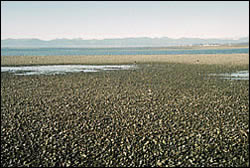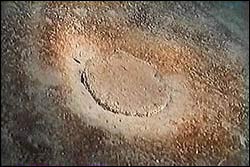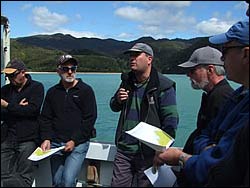Coastal and Marine
 |
Motueka delta |
Introduction
Productivity - and therefore the economic value - of the coastal marine environment is dependent on an adequate supply of nutrients, such as nitrogen and phosphorous, to support photosynthetic (plant) uptake and growth. Either an over or an under supply can negatively impact on the sustainability of coastal resources.
There are three major sources of plant nutrients in coastal seawaters:
- freshwater tributaries which discharge terrestrial nutrients;
- the upwelling of nutrient rich seawaters from deep sea environments where lack of light prevents plant uptake;
- regeneration and recycling of nutrients through animal excretion and microbial mineralisation processes.
To quantify the importance of these effects it is necessary to identify the nature, magnitude and spatial extent of freshwater influences on the coastal sea environment.
Coastal productivity is also dependent on an adequate supply of light for photosynthesis. Sediments discharged into the coastal environment through freshwater tributaries can effect the light availability for plant growth. In addition, when these sediments settle to the sea floor, they can play an important role in dictating the physical and chemical properties (and consequently the plant and animal communities) of the benthic environment.
Coastal productivity and, perhaps more importantly, the quality of the coastal resource can also be affected by a wide variety of contaminants discharged through freshwater tributaries. We require more information regarding the mechanisms of release of contaminants into the coastal environment and how they may impact on coastal resources.
Researchable Issues
- How do variations in the volume of the freshwater discharge affect the ecology of the coastal environment?
- How do variations in the quality of the freshwater discharge affect coastal ecosystems?
- What are the implications for fisheries management and aquaculture?
Research Areas
-
Delta habitat mapping
Characterisation of catchment–built delta habitats. -
Ecosystem models of Tasman & Golden Bays
The ultimate aim of environmental studies is to develop the ability to predict ecosystem responses to particular events. This can be achieved through the use of predictive models. -
Faecal bacteria in the Motueka River
-
Fine sediment: bringing the geomorphology and biology together
Suspended sediment effects on freshwater and coastal habitats. -
Long term in–situ data collection in Tasman Bay
What are the short term (e.g. flood related), seasonal and long term (e.g. interannual) relationships between the quantity/quality of Motueka River inflows and the water column characteristics of western Tasman Bay. -
River plume ecosystem
Are there definable ecosystem characteristics that are significantly affected by the freshwater discharge from the Motueka River? -
Sediment generation, delivery and impacts
Sediment may have a range of impacts on the ecology and habitat of both freshwater and marine ecosystems. To understand and manage these impacts it is important to determine the major sources of sediment generation as well as establish changes in riverbed characteristics important to maintenance of the trout fishery, and delivery of sediment to the marine environment. -
Tasman Bay productivity
Fish and shellfish resources in Tasman Bay are highly variable in terms of their distributions, growth rates and reproductive success. To manage them sustainably, requires an understanding of factors that control that variability and how the ecosystem in general functions.
 |
 |
Benthic diatom |
AGM 2006 - Russell Mincher |
Publications (Selection)
Presentations (Selection)
Primary Contacts:

|
Paul Gillespie
Email Phone: 03 548 2319 Fax: 03 546 9464 |
Institute Cawthron Institute |
Expertise Estuarine & marine microbial ecology |
Page last updated Tuesday, 20 November 2007